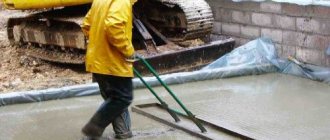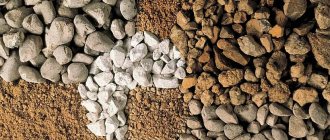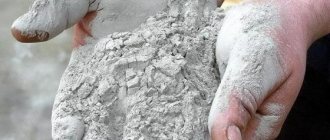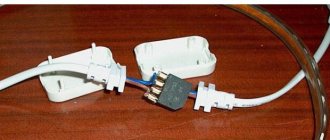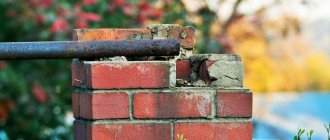Is it possible to pour the foundation in the fall? It is possible, but you need to take into account a number of factors, which you will read about in detail in this material. We will also look at when is the best time to pour a foundation and how to do it. The foundation must be strong and durable; autumn should not interfere with your construction. Autumn filling has its pros and cons. If you approach the work correctly, then at the end you can get a high-quality foundation that will not be inferior to the summer version. Gross mistakes can lead to the fact that instead of building load-bearing walls, you will have to remove defective concrete.
Features of autumn filling
Take these weather factors into account, and the foundation will be of high quality:
- Temperature. It is necessary to create an optimal regime - the cement mixture hardens best at 16-25 degrees. In summer, the temperature is much higher, which negatively affects the strength of the foundation. If the indicator is lower than optimal, the hardening will take longer, but it will not stop. The most destructive thing for concrete will be frosts, which occur even in September.
- Precipitation. The arrival of autumn is often accompanied by rainy weather. Excess liquid harms the material. Long rains can even wash away cement laitance, as a result, the grade of concrete decreases.
- Groundwater. This factor must first be taken into account by people planning to build in swampy areas. In September, the water level may be lower than in the warm season. Prolonged rains can completely interrupt construction, as groundwater fills the trenches.
- Humidity. Novice builders may think that this indicator negatively affects the hardening of the concrete mixture, but in fact the opposite is true - the concrete dries slowly. Accordingly, it becomes stronger. If the humidity outside is high, you won't need to humidify.
Frost protection measures
The most negative factor for foundation construction in the fall is frost.
Low temperatures not only reduce the strength of the emerging concrete structure, they can lead to complete destruction of the foundation.
If frost takes builders by surprise, it is necessary to use the recommendations from the set of measures for protection against frost.
The simplest way is to simply cover the concrete with a heat insulator, which can be made from either special or improvised materials, such as straw, leaves, etc. The essence of the method is that during the first frost, excess heat remains in the ground. By using a thermal insulation layer, this heat can be retained longer. The method is very cheap and ineffective.
These additives allow concrete to gain strength, despite frosts at temperatures down to -20°C.
More serious protection against frost are special anti-frost additives in the concrete itself. Depending on the type of concrete used and the composition of the additives, they have different properties, dosages and prices.
The most effective protection is electrical heating of the foundation. Previously, pit and portable ovens were used for such purposes, but this method is quite labor-intensive. Electric heating provides high-quality protection from frost with minimal effort from builders. The disadvantage is the increased cost compared to other methods. The heating cable is installed on the foundation along with a heat insulator. It is important to prevent the foundation from overheating. The amount of cable and power of electricity depends on the area of the foundation, the ambient temperature, and the composition of the concrete. You can determine the required values yourself, but it is better to leave this work to professional consultants.
Typically, the solidification and initial formation of the foundation is carried out within a month, which is how long it is necessary to protect it from frost.
All methods of heating concrete can be used separately and in combination.
The strength characteristics of a construction project depend on the quality of the foundation pouring. This serious stage of work requires a thorough approach. Time and weather factors sometimes change the plans of developers. Situations arise when the foundation is poured in the fall.
There is an opinion that the construction of buildings is carried out exclusively in the summer, when the ambient temperature is 16 °C - 25 °C. Professional builders have proven that this position is not justified. Completing the foundation in the fall is possible. However, it has positive and negative aspects. By taking a responsible approach to organizing the work, you can ensure the solidity of the foundation, which will be no different from the foundation poured in the summer.
If you make serious mistakes, you risk in early spring, instead of constructing a building, you will begin to remove parts of the cracked base and dispose of them. To the question whether it is possible to pour the foundation in the fall, we answer in the affirmative. We will tell developers in detail about the features of autumn pouring, methods of protection from freezing temperatures, and advise on the best way to lay concrete.
Modern builders are proving that pouring concrete can be done in the fall if the necessary recommendations are followed.
The right time of year
It is necessary to think through construction in order to take advantage of the benefits of the autumn period. If you ask a professional builder what time of year is best to pour the foundation, he will answer you - in early autumn or spring. Two conditions must be met - warm weather and high humidity. Concrete takes about 25-30 days to gain the required strength.
In the first months of autumn, frosts occur, but quite rarely. If necessary, the structure can always be protected from low temperatures. As for groundwater and precipitation, they are not so dangerous for the foundation, since excess liquid can cause serious damage to the foundation only in the first days after pouring. The mixture sets in 24-40 hours, after which the concrete gains strength.
Pouring concrete in the fall: where to start?
When planning the construction of a concrete structure in the autumn, you should know what weather factors affect the quality of the final product or structure. There are several objective factors, and they are well known to construction specialists:
- Ambient temperature. The optimal temperature regime for setting and strengthening of concrete is a temperature “differential” from 16 to 25 degrees Celsius. As the temperature decreases, cement hydration slows down, which has a positive effect on strength gain. It is very important that the concrete does not freeze. If this happens, the frozen water will literally “tear” the flooded structure from the inside. This is the main danger that comes with pouring concrete in the fall;
- Increased environmental humidity. This is a positive factor that allows us to exclude constant wetting of the concrete surface from the technology;
- Rain and downpours erode concrete, wash cement out of the surface and reduce its strength. This is a negative factor;
- Groundwater. A negative factor that requires either carrying out measures to dry the site, or using special construction technology, or postponing construction to the summer.
At the same time, if you think through and prepare everything before carrying out work, you can avoid the influence of negative factors and take full advantage of the positive aspects of autumn - the absence of summer heat and high environmental humidity.
Protection from precipitation and frost
Monitoring precipitation is quite simple: follow the weather forecast and choose days for pouring when no rain is expected. There must be at least three days in reserve. If precipitation takes you by surprise, you need to quickly cover the “ribbons” with oilcloth. It is more difficult to protect from frost, and the procedure will be expensive. Some people prefer to simply cover the base - this is a cheap and ineffective way. Next come special anti-frost additives. If you buy high-quality additives, concrete will normally gain strength even at -15 degrees.
Rules for pouring in cold weather
One of the SNiP points contains information about laying the foundation in cold weather. Below are important excerpts from these rules:
- If the temperature outside is low, mix indoors. The ideal temperature for kneading is 20-25 degrees. As an alternative, heated mixers can be used. So, you already know at what temperature you can pour the foundation in the fall.
- Use heated mixtures, fillers and water. Pieces of ice or lumps will ruin the entire solution, so make sure that all liquids are at the right temperature. The water should not be colder than 70 degrees.
- The lower the temperature, the longer it takes to mix the concrete. If we take autumn, then the process should last ¼ longer than in summer.
- If there have been recent frosts, then it is necessary to check the formwork and soil before pouring. They shouldn't be frozen. If you ignore this, the mixture will also freeze. It is better to wait until the soil and formwork “even out” in temperature.
- It is worth taking care of the reinforcement frame. Warm it up so that frozen areas of the solution do not form around the rods.
- Increase the vibration pressing time by ¼ compared to the warm period.
- If frost occurs, you should check whether the concrete has gained strength of 5 MPa or more. This did not happen? Then you should take care of warming up the base.
Is it possible to pour the foundation in the fall - technology features
Most people have a stereotype that it is necessary to fill the foundation only in spring and summer. Modern builders are proving that pouring concrete can be done in the fall if the necessary recommendations are followed. Such a properly executed foundation will not be inferior in performance characteristics to its summer counterparts.
Some information about autumn filling
Construction of the foundation is one of the main procedures of building construction. Depending on the correctness and accuracy of construction, taking into account all external factors, you can obtain a solid concrete base and begin building walls. If the construction process was carried out incorrectly, there is a risk of subsequent disposal of the foundation due to its unsuitability. The result is wasted time, money and effort.
In addition to the human factor, the pouring of the foundation is influenced by weather conditions. In autumn, as a rule, air humidity increases, temperature decreases, precipitation increases, the amount of groundwater increases, and so on. The listed factors may seem undesirable for pouring a foundation in the fall, however, most of them are advantages.
Taking into account the influence of temperature, we can conclude that it is advisable to fill the foundation in the fall, and not in the summer.
The best temperature regime for concrete hardening is from +15 to +25 °C. In most summer periods, the temperature significantly exceeds this range, which leads to anisotropy of properties, when concrete hardens, and the appearance of significant and minor defects. Therefore, from the point of view of the influence of temperature, it is better to fill the foundation in the fall. In the autumn, concrete hardens much more slowly, but the quality will remain high.
The process of building a foundation and its quality are affected by air humidity. Contrary to popular belief, increased humidity has a positive effect on concrete drying. When pouring in the fall, there is no need for additional moisture.
Precipitation negatively affects such construction work in the fall. You can pour concrete during this period, however, you should choose non-rainy periods. A large amount of water reduces the quality and performance properties of the solution.
An advantage for laying a foundation in the fall compared to summer is the groundwater level, which is often significantly lower than in the summer . There should be no water in the trench. If water appears during digging, construction work must be stopped immediately and postponed indefinitely, depending on the terrain and weather conditions.
Recommendations from professionals: pour concrete in the fall
If you decide to carry out construction work in the fall, you should consider the following factors:
- Antifreeze additives will definitely not harm the concrete mixture, and you can be safe from sudden frosts. Residents of the CIS probably know that even relatively warm regions are not immune from a sharp drop in temperature.
- Alternating thawing and freezing are the worst conditions for concrete to harden. You shouldn’t do the work when the temperature is above zero during the day and below zero at night. That is why professionals recommend filling in mid-spring (April, early May) or in the first months of autumn.
The table shows the percentage of strength and the effect of temperature on this process
Electric foundation drying
There is another great way to dry out the foundation. When pouring it, a wire is placed in the solution. It can be copper, steel or aluminum. On one side, all ends are divided into two bundles; they will be connected to the welding machine. Light bulbs are connected to the other side, two ends to each. The lamps must be 36 V, the most important thing is that everything needs to be connected correctly. If there is an error somewhere, then nothing will work. Next, the wires are connected to the lamps in pairs and connected to the device. The first ones should light up, at first with a dim light, but as the concrete begins to dry out, they will burn brighter and brighter. This way you can perfectly monitor the progress of the entire operation and know when the foundation is ready. This method is also suitable for heating the foundation in October or other cold months.
Many builders generally prefer pouring concrete in the fall, because it does not dry out, as happens in the summer heat. The pouring method, or more precisely, the method of retaining heat in the mixture, must be chosen based on weather conditions, available equipment and materials.
Most people have a stereotype that it is necessary to fill the foundation only in spring and summer. Modern builders are proving that pouring concrete can be done in the fall if the necessary recommendations are followed. Such a properly executed foundation will not be inferior in performance characteristics to its summer counterparts.
Some information about autumn filling
Construction of the foundation is one of the main procedures of building construction. Depending on the correctness and accuracy of construction, taking into account all external factors, you can obtain a solid concrete base and begin building walls. If the construction process was carried out incorrectly, there is a risk of subsequent disposal of the foundation due to its unsuitability. The result is wasted time, money and effort.
In addition to the human factor, the pouring of the foundation is influenced by weather conditions. In autumn, as a rule, air humidity increases, temperature decreases, precipitation increases, the amount of groundwater increases, and so on. The listed factors may seem undesirable for pouring a foundation in the fall, however, most of them are advantages.
Taking into account the influence of temperature, we can conclude that it is advisable to fill the foundation in the fall, and not in the summer.
The best temperature regime for concrete hardening is from +15 to +25 °C. In most summer periods, the temperature significantly exceeds this range, which leads to anisotropy of properties, when concrete hardens, and the appearance of significant and minor defects. Therefore, from the point of view of the influence of temperature, it is better to fill the foundation in the fall. In the autumn, concrete hardens much more slowly, but the quality will remain high.
The process of building a foundation and its quality are affected by air humidity. Contrary to popular belief, increased humidity has a positive effect on concrete drying. When pouring in the fall, there is no need for additional moisture.
Precipitation negatively affects such construction work in the fall. You can pour concrete during this period, however, you should choose non-rainy periods. A large amount of water reduces the quality and performance properties of the solution.
An advantage for laying a foundation in the fall compared to summer is the groundwater level, which is often significantly lower than in the summer . There should be no water in the trench. If water appears during digging, construction work must be stopped immediately and postponed indefinitely, depending on the terrain and weather conditions.
Pouring the foundation in summer
Pouring concrete in the summer allows you to complete the necessary work in the shortest possible time and at minimal cost.
This is due to the fact that in summer the temperature is between 20-25 degrees Celsius. However, even in summer you need to monitor the temperature. When it reaches 30 degrees, the concrete mixture loses a number of its properties. Therefore, before laying the foundation, it is worth studying the weather forecast for at least 2 weeks. In summer, the foundation is poured in early June. This month is not hot, but quite warm. In addition, the required level of humidity is maintained in June.
A remark needs to be made here. Even in summer, you should not carry out foundation work in rainy weather. During the setting process, moisture negatively affects the quality of the concrete mixture. Therefore, if it starts to rain immediately after laying, the concrete should be covered with plastic film.
Method of pouring the foundation in the fall
According to the recommendations of specialists and experienced builders, for the construction of foundations in the autumn and winter periods it is necessary to follow certain rules. These rules are also specified in SNiP, “Load-bearing and enclosing structures”:
- It is necessary to carry out work on mixing the solution in warm, enclosed spaces;
- during the mixing process, it is necessary to use heated water, at a temperature not exceeding +70 °C, the structure of the mixed concrete should be as homogeneous as possible;
- the concrete mixing time increases by a quarter relative to the mixing time in the summer;
- the reinforcement frame for the future foundation should be slightly heated to prevent the appearance of ice crystals on it;
- formwork, supports and foundations should also not be very cold in order to prevent pre-freezing of concrete;
- the time of pressing the foundation by vibration increases by a quarter, as well as the time of mixing concrete, relative to the time of pressing the foundation in the summer.
Filling should be done as carefully as possible, slowly. Any even minor defect can cast doubt on the normal operation of the building in the future.
There are times when the situation gets out of control. In the midst of work, it may start to rain. The situation is unpleasant, but not critical. First of all, it is necessary to prevent excess water from entering the concrete mixture. Protection of poured concrete is carried out using film, tarpaulin and other waterproofing materials, which are covered over the poured concrete solution in the formwork. Before starting work, it is necessary to prepare waterproof materials or build small portable shelters from wood and slate, for example. If detected late, excess water can be carefully removed manually when it accumulates on the concrete surface. If rain catches the foundation two days after it was poured, excess water will not harm the concrete.
Watch a video about the consequences of pouring a foundation in the rain:
Pouring the foundation in autumn or spring
If necessary, laying concrete supports is carried out not only in the summer, but also in the so-called off-season - in autumn or spring. But in this case, builders should remember the danger posed by spring and autumn frosts. In March-April and October-November, temperatures often drop below zero. Alternate thawing and freezing of the concrete mixture is the worst thing that can happen to it. Therefore, when planning construction work for this period, it is worth insuring yourself by adding anti-frost compounds to the concrete mixture.
Pouring the foundation in winter
Modern technologies make it possible to pour concrete for the foundation even in winter. But such concreting is a more labor-intensive and expensive process. The cost of work may increase by 30-50%.
In order to fill the foundation in winter it is necessary:
- prepare equipment for electrical heating;
- purchase hardening accelerators;
- find a competent specialist who has experience in performing construction work in such conditions;
- select high-quality antifreeze additives;
- stock up on plenty of insulation materials.
Another option for winter pouring involves the use of a special awning, which will protect against precipitation and allow the use of heat guns to provide the necessary conditions for hardening of the concrete mixture. But in this case, the cost of work will increase even more. To summarize, it is worth saying that it is advisable to fill the foundation in late spring or summer.
- Previous article Shrinkage cracks in concrete: causes and ways to eliminate them
- Next article Protecting the foundation from water
Pouring the foundation in the fall - what developers need to know
It must be said right away that any construction work at sub-zero temperatures undoubtedly loses in quality; it should be carried out only in cases of various force majeure situations.
Concrete is not a piece of stone, but a combination of various ingredients between which chemical reactions occur. Concrete “ripens” in two stages – setting and hardening.
For favorable reactions, a temperature of +3+25°C is considered; this is technologists’ answer to the question at what temperature the foundation can be poured without the use of special additives and technologies.
The higher the temperature and humidity, the faster and better the process of setting and hardening of concrete occurs, the better its physical strength indicators.
The strength of the foundation is taken into account when developing technical documentation for the construction of a building. If the actual values are lower than the calculated ones, then the risks of emergency situations increase, and the operating time of the building is significantly reduced.
Of course, the strength factors are directly influenced by the brand of cement and the mass ratio of concrete components.
But pouring the foundation in the fall is not the only problem with concrete quality. In the autumn period, the productivity of workers sharply decreases, and great difficulties arise for the operation of special construction equipment.
As a result, the estimated cost of the building increases while all quality parameters decrease.
At what temperature can the foundation be poured?
Concrete is a unique building material that has been increasing its strength for many decades. Concrete reaches the first 50% of its maximum strength after 28–30 days; subsequently, the processes of increasing strength slow down and extend over time over a long period.
50% strength makes it possible to continue working on concrete architectural structures; it is this period of time that is considered the initial period during the preparation of design estimates.
Is it possible to pour the foundation in October? It is possible if there are favorable temperature forecasts for the next two to three weeks.
If the temperature drops below +3°C, extremely negative irreversible processes occur in concrete, and the beginning of the transformation of water into ice is a destructive barrier for the material. Currently, there are various and quite effective additives that prevent water from freezing.
Several decades ago, ordinary table salt was used as additives. It had a very negative effect on the condition of the reinforcement; the structure of the concrete could not reach optimal values due to the high concentration of salts. Although concrete does not freeze, the use of additives has several disadvantages.
- The cost of concrete work increases significantly. Every developer should keep this in mind before making a final decision at what temperature to pour the foundation.
- The quality of construction work is deteriorating. Modern technologies make it possible to carry out concrete work even at temperatures of -5÷8°C, you just need to weigh whether this is always justified. Is it worth pouring the foundation in the fall, risking its quality, spending significantly more financial resources if further construction work will be carried out only with the onset of spring?
Based on the above, it is difficult to unambiguously answer the question at what temperature the foundation for a house is poured. Much depends on various individual indicators.
Is it possible to pour the foundation in October?
If absolutely necessary, such work can be carried out, but various methods should be used to protect the structure from freezing water. Construction technologies provide four methods.
- Heating the water temperature to +30°C. The method is effective in the construction of massive monolithic foundations; it increases the time for favorable chemical reactions to occur by 5–6 days. At what temperature can the foundation be poured in the fall using this method? Technologists recommend using water heating when daytime temperatures are above zero and there is slight frost at night.
- Use of additives against freezing of water. The foundation for a house can be poured on frosty days. Limitation - the high cost of concrete mortar makes the work economically unviable for large foundations; the method is used only for columnar types or for pouring hollow piles.
- The use of various insulation materials. Pouring the foundation in the fall with insulation of the structure allows you to increase the comfortable hardening time. Chemical processes release a small amount of thermal energy; covering the foundation increases the time of optimal conditions for their occurrence. Sheets of foam plastic about three centimeters thick are laid on the sides of the foundation; they not only serve as effective insulation, but also compensate for the pressure of the soil during its freezing/thawing.
- Heating by electric current. Electrical cables are laid into the foundation, through which a low voltage but high current current is passed. There are schemes for connecting current to a reinforcing stack; the calculator does not affect the calculation of reinforcement for a strip foundation; its quantity remains the same. More attention is paid to the quality of the bundle of rods to ensure reliable contact. If you have the opportunity to install electric heating, then the question at what temperature you can pour the foundation in the fall disappears. Everything depends only on financial capabilities - with current energy prices, the cost of work will increase by an order of magnitude.
Professional builders advise developers not to think about whether it is possible to pour the foundation in October, but to take all measures to avoid this. There is such an objective concept - a favorable construction season. The month of October is not included in this season. not included in this season.
Specifics of autumn filling
Construction in the rainy autumn is not as comfortable as in the summer, when concrete quickly gains strength. But if there is no alternative, you managed to dig a trench before frost, pour the concrete solution in early autumn, then the foundation will have time to acquire the required strength characteristics. By performing the work correctly, you can avoid subsidence of the foundation and subsequent deformation of the building walls.
Let's consider what weather factors determine the quality of work if the foundation is planned to be poured in the fall:
- Temperature regime.
The favorable temperature for setting and hardening of the concrete mixture is considered to be from 3 to 25 degrees Celsius. Elevated temperatures negatively affect strength, and at lower temperatures, hydration occurs worse. Favorable temperatures ensure slow hardening of the concrete solution in the autumn, significantly improving the strength characteristics. It is important to have time to complete the work before the soil freezes, when it swells under the influence of moisture. If a sharp drop in temperature is not expected, then get to work. - Ground water level.
If work is carried out in a swampy area or soil characterized by high humidity, pay attention to this factor. Despite the fact that in the first autumn months, when it does not rain, the level of groundwater layers is low, but the beginning of autumn rains contributes to a rise in the level. In unfavorable conditions, it is not advisable to build a foundation. We'll have to reschedule work until the spring.
If the construction process was carried out incorrectly, there is a risk of subsequent disposal of the foundation due to its unsuitability
Preparation before pouring the foundation in the fall
To carry out foundation construction work in the fall, it is necessary to carefully plan the entire process in order to make the most of the advantages and avoid the disadvantages of the autumn period as much as possible.
The first step in planning will be choosing the area and marking it. These jobs can be done in the summer. Experts recommend digging a pit by the end of summer, beginning of autumn, so that the soil is not sufficiently wet or frozen. This choice is aimed at making digging easier. Also, before digging a pit, it is necessary to check for the presence of groundwater below the surface. When part of the pit has been dug, it is necessary to drill a small test shaft, as before digging wells, but to a much shallower depth. A few meters will be enough. If there is no water, you can safely continue work. If a source of water appears, it is necessary to choose another place to build a house, since the groundwater level rises significantly in winter and spring.
Experienced workers recommend pouring the foundation closer to mid-autumn, at the end of September and the first half of October.
A significant disadvantage of autumn is the unpredictability of the weather, as rain can appear at any moment. You should use the most accurate available weather forecasts to select a period with minimal precipitation and no frost. The presence of frost spoils the foundation that has not yet hardened; it tends to collapse from the inside during frost. Precipitation is not dangerous if it appears at least 2 days after pouring the foundation, by which time the concrete will have partially hardened.
It is necessary to take into account the characteristics of the soil in order to avoid subsidence of the foundation in winter due to water crystallization. The foundation hardens and stabilizes, depending on the area, for up to 6 months. In most cases, you can start laying walls already in winter. According to these recommendations and modern construction methods, it is definitely possible to build a foundation in the fall.
In addition, the price of building materials most often decreases in the fall, which allows you to save money. But if you carry out such work in winter, it will be difficult to make concrete yourself. There will be a need to order concrete from the plant, which will increase the cost of work.
Useful video about what to do at a construction site in late autumn:
